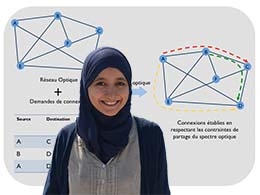17th Journées Combinatoire et Algorithmes du Littoral Méditerranéen (JCALM)
- Main topic: Designs
- When: May 4-5, 2017
- Where: Sophia Antipolis, France
- Link: conference website
17th Journées Combinatoire et Algorithmes du Littoral Méditerranéen (JCALM)
Participez aux Journées non thématiques RESCOM 2017 (12-13 janvier 2017) et à la journée thématique RESCOM Communication dans la ville intelligente (11 janvier 2017). Ces évènements sont organisés dans l’amphi Kahn de Inria Sophia Antipolis – Méditerranée et dans la salle E+131 de Polytech sur le Campus SophiaTech.
Le programme et les informations pratiques sont disponibles sur la page des journées.
Abstract: Large scale communication networks are everywhere, ranging from data centers with millions of servers to social networks with billions of users. This thesis is devoted to the fine-grained complexity analysis of combinatorial problems on these networks.
In the first part, we focus on the embeddability of communication networks to tree topologies. This property has been shown to be crucial in the understanding of some aspects of network traffic (such as congestion). More precisely, we study the computational complexity of Gromov hyperbolicity and of tree decomposition parameters in graphs – including treelength and treebreadth. On the way, we give new bounds on these parameters in several graph classes of interest, some of them being used in the design of data center interconnection networks. The main result in this part is a relationship between treelength and treewidth: another well-studied graph parameter, that gives a unifying view of treelikeness in graphs and has algorithmic applications. This part borrows from graph theory and recent techniques in complexity theory.
The second part of the thesis is on the modeling of two privacy concerns with social networking services. We aim at analyzing information flows in these networks, represented as dynamical processes on graphs. First, a coloring game on graphs is studied as a solution concept for the dynamic of communities. We give a fine-grained complexity analysis for computing Nash and strong Nash equilibria in this game, thereby answering open questions from the literature. On the way, we propose new directions in algorithmic game theory and parallel complexity, using coloring games as a case example. Finally, we introduce a new learning problem that is motivated by the need for users to uncover any misuse of their personal data online. We give positive and negative results on the tractability of this problem.
All the publications at the core of this thesis are available online here
Keywords: Graph theory, Hyperbolicity, tree-decomposition, complexity, privacy.

Abstract: The disjoint set union problem is a classical problem in data structures with a simple and efficient sequential solution that has a notoriously complicated analysis. One application is to find strongly connected components in huge, implicitly defined graphs arising in model checking. In this application, the use of multiprocessors has the potential to produce significant speedups. We explore this possibility. We devise and analyze concurrent versions of standard sequential algorithms that use single and double compare-and-swap primitives for synchronization, making them wait-free. We obtain work bounds that grow logarithmically with the number of processors, suggesting the possibility of significant speedup in practice. This is ongoing joint work with Siddhartha Jayanti, an undergraduate at Princeton.
Short Bio: Since 1985, Robert E. Tarjan has been the James S. McDonnell Distinguished University Professor of Computer Science at Princeton University. He previously held academic positions at Cornell, Berkeley, Stanford, and NYU, and industrial research positions at Bell Labs, NEC, Intertrust Technologies, HP, and Microsoft. Among other honors, he received the Nevanlina Prize in Informatics, given by the International Mathematical Union, in 1982, and the A.C.M. Turing Award in 1986. He is a member of the National Academy of Sciences and the National Academy of Engineering, and a Fellow of the American Philosophical Society and the American Academy of Arts and Sciences. He has published over 250 papers, mostly in the areas of the design and analysis of data structures and graph and network algorithms.
The team composed of Nathann Cohen (CNRS, LRI, Paris XI) and David Coudert won the Flinders Hamiltonian Cycle Problem (FHCP) Challenge organized by the Flinders Hamiltonian Cycle Project (Flinders University, Adelaide, Australia).
The challenge consisted in solving 1001 instances of the Hamiltonian Cycle Problem over a one year period (September 30 2015 till September 30 2016). The FHCP Challenge Set is a collection of 1001 instances of the Hamiltonian Cycle Problem, ranging in size from 66 vertices up to 9528 vertices, with an average size of just over 3000 vertices.
We were able to solve 985 instances!

Fatima Zahra Moataz is the recipient of an accessit to the PhD prize Graphes “Charles Delorme” 2016 for her PhD thesis entitled Towards Efficient and Fault-Tolerant Optical Networks: Complexity and Algorithms. Congratulations !
The prize will be announced during the next Journées Graphes et Algorithmes — Paris, November 17, 2016.

Abstract: We study in this thesis optimization problems with application in optical networks. The problems we consider are related to fault-tolerance and efficient resource allocation and the results we obtain are mainly related to the computational complexity of these problems.
The first part of this thesis is devoted to finding paths and disjoint paths. Finding a path is crucial in all types of networks in order to set up connections and finding disjoint paths is a common approach used to provide some degree of protection against failures in networks. We study these problems under different settings. We first focus on finding paths and vertex or link-disjoint paths in networks with asymmetric nodes, which are nodes with restrictions on their internal connectivity. Afterwards, we consider networks with star Shared Risk Link Groups (SRLGs) which are groups of links that might fail simultaneously due to a localized event. In these networks, we investigate the problem of finding SRLG-disjoint paths.
The second part of this thesis focuses on the problem of Routing and Spectrum Assignment (RSA) in Elastic Optical Networks (EONs). EONs are proposed as the new generation of optical networks and they aim at an efficient and flexible use of the optical resources. RSA is the key problem in EONs and it deals with allocating resources to requests under multiple constraints. We first study the static version of RSA in tree networks. Afterwards, we examine a dynamic version of RSA in which a non-disruptive spectrum defragmentation technique is used.
Finally, we present in the appendix another problem that has been studied during this thesis. It is a graph-theoretic problem referred to as minimum size tree-decomposition and it deals with the decomposition of graphs in a tree-like manner with the objective of minimizing the size of the tree.
Keywords: Asymmetric nodes, forbidden transitions, shared risk link group, routing and spectrum assignment, tree-decomposition, complexity.

Abstract: Multicore architectures Intel Core (IvyBridge, Haswell, etc.) contain both general purpose CPU cores (4) and dedicated GPU cores embedded on the same chip (16 and 40 respectively). As part of the activity of Kontron (the company partially funding this CIFRE scholarship), an important objective is to efficiently compute arrays and sequences of fast Fourier transforms (FFT) such as one finds in radar applications, on this architecture. While native (but proprietary) libraries exist for Intel CPU, nothing is currently available for the GPU part.
The aim of the thesis was to define the efficient placement of FFT modules, and to study theoretically the optimal form for grouping computing stages of such FFT according to data locality on a single computing core. This choice should allow processing efficiency, by adjusting the memory size available to the required application data size.
Then the multiplicity of cores is exploitable to compute several FFT in parallel, without interference (except for possible bus contention between the CPU and the GPU). We have achieved significant results, both in the implementation of an FFT (1024 points) on a SIMD CPU core, expressed in C, and in the implementation of a FFT of the same size on a GPU SIMT core, then expressed in OpenCL.
In addition, our results allow to define rules to automatically synthesize such solutions, based solely on the size of the FFT (more specifically its number of stages), and the size of the local memory for a given computing core. The performances obtained are better than the native Intel library for CPU, and demonstrate a significant gain in consumption on GPU. All these points are detailed in the thesis document.
These results should lead to exploitation of the code as library by the Kontron company.
Keywords: FFT, GPU, multicores.
16th Journées Combinatoire et Algorithmes du Littoral Méditerranéen (JCALM)
Fatima Zahra Moataz received the best student paper award of the conference ALGOTEL 2015 for her paper entitled “On Spectrum Assignment in Elastic Optical Tree-Networks“.
Abstract: To face the explosion of the Internet traffic, a new generation of optical networks is being developed; the Elastic optical Networks (EONs). The aim with EONs is to use the optical spectrum efficiently and flexibly. The benefit of the flexibility is accompanied by more difficulty in the resource allocation problems. In this report, we study the problem of Spectrum Allocation in Elastic Optical Tree-Networks. In trees, even though the routing is fixed, the spectrum allocation is NP-hard. We survey the complexity and approximability results that have been established for the SA in trees and prove new results for stars and binary trees.
Keywords: Interval coloring; Optical networks; Routing and Spectrum Assignment; Approximation algorithms.